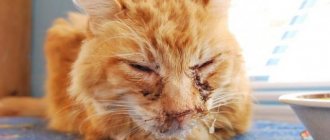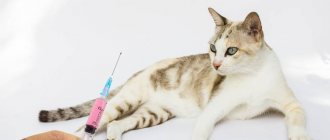Victoria Rashidovna Khazimulina
veterinarian Petstory
Mycoplasmosis in cats is an infectious disease, most often asymptomatic, but under certain conditions it affects the respiratory, urinary, reproductive, musculoskeletal systems and eyes. The causative agents of mycoplasmosis are gram-negative bacteria that do not have a cell membrane. They invade mucosal epithelial cells and destroy them. However, mycoplasmas are often found in clinically healthy animals, which indicates their opportunistic nature. Will the detection of these bacteria always mean that the animal needs treatment? Let's look at this question below.
Mycoplasmosis in cats: the main thing
- Mycoplasmas are a group of gram-negative microbes that are not always dangerous for cats.
- The cause of the development of mycoplasmosis in cats, as a rule, is a concomitant infection, damage to the mucous membranes or a disorder of the immune response.
- Infection occurs through contact with an infected animal.
- The most common symptoms are redness of the mucous membranes, discharge from the eyes and nose, coughing, sneezing, and fever. However, there may be other abnormalities, depending on the location of the infection (lameness, pain when urinating, discharge from the loop, etc.).
- Diagnosis consists of a thorough history taking, examination, and mycoplasmosis is finally confirmed by PCR or bacteriological culture.
- Treatment depends on the severity of symptoms and associated pathologies. As a rule, antibiotics are used locally and systemically. But the drug must be prescribed by a doctor, since not every antibiotic acts on these microorganisms.
- The main preventive measure is a healthy lifestyle (timely vaccination, proper diet, personal hygiene).
- Feline mycoplasmosis is not dangerous to humans. However, you should follow the rules of personal hygiene (wash your hands, do not kiss your pet, etc.).
Ways of helminths entering the body
There are several of them, but the most common ways are four:
- From person or animal to person. This is how, for example, pinworm infection occurs. If a person infected with this type of worms touches various objects without washing their hands, then this will become a risk factor for others (it is not without reason that enterobiasis - and this is what pinworm infection is called - is an occupational disease of teachers, because pinworms are a real scourge of primary schoolchildren) .
- Through the soil. Worm eggs enter it along with human and animal feces, after which they are carried by water, insects, pets or wind (with dust particles) and end up on food or directly into the digestive tract or respiratory tract.
- When eating food that has not been subjected to heat treatment. Raw or half-raw meat or fish infected with worms are very dangerous. Therefore, you should very carefully choose restaurants that serve sushi.
- For insect bites. This happens quite rarely, but the risk of contracting helminthiasis through a bite increases when traveling to exotic countries.
Causes of the disease
As we said earlier, mycoplasma is often detected in tests in clinically healthy cats. The fact is that a healthy body is quite capable of protecting itself from this bacterium.
Most often, mycoplasmosis in cats develops due to a violation of the barrier function of the mucous membranes.
Thus, the cause of the disease may be:
- Complications of other diseases (asthma, herpesvirus, calicivirus, chlamydia, bordetellosis, etc.);
- Decreased immunity (viral immunodeficiency, taking immunosuppressants);
- Violation of the barrier function of mucous membranes (allergies, hypothermia, stress);
- Entering the body of a large amount of the pathogen - for example, through close contact with an infected animal.
Infectious agents
Representatives of the mycoplasma class are the smallest free-living microorganisms with a unique structure.
The absence of a cell wall makes these infectious agents similar to viruses, but in the scientific community mycoplasmas are still considered bacteria. Also, the unique biological properties of these microorganisms include the ability to maintain vital activity in a cell-free environment and the absence of a nucleus. Mycoplasmas are not Gram stained and cannot be identified using a light microscope. The absence of a rigid cell wall explains the numerous protective properties of mycoplasmas. These bacteria are resistant to many antimicrobials, including beta-lactam antibiotics. Conditionally pathogenic representatives of mycoplasmas live in the mucous membranes of various anatomical areas, including the genitourinary and respiratory tracts. Active spread of these microorganisms into the submucosa and bloodstream is observed only in immunosuppressive conditions. In this case, the bacteria can cause a systemic infection.
Representatives of mycoplasmas and associated diseases:
- Mycoplasma pneumoniae is a well-studied infectious agent that causes atypical pneumonia;
- Ureaplasma urealyticum and Ureaplasma parvum are responsible for the occurrence of nonspecific urethritis and other inflammatory processes in the genitourinary system;
- Mycoplasma hominis and Mycoplasma genitalium also affect the organs of the excretory and reproductive systems;
- Mycoplasma incognitos can provoke the development of disseminated infection.
Scientists also know of individual representatives of this bacterial class that can cause inflammatory processes in HIV-infected people. Further study of mycoplasmas will help doctors improve treatments for these diseases.
Symptoms
Symptoms of mycoplasmosis in cats depend on the location of the disease. Mycoplasma can affect the eyes, respiratory, urinary, reproductive systems and even joints.
Therefore, the symptoms of this disease are very varied:
- Copious nasal discharge, sneezing, nasal congestion;
- Cough;
- Pain when swallowing;
- Excessive discharge from the eyes, redness of the conjunctiva, clouding of the eyes;
- Fever;
- Rapid breathing (tachypnea);
- Increased breath sounds;
- Frequent and painful urination, blood in the urine;
- Swelling of the joints, lameness;
- A sign of cystitis is frequent, painful urination;
- Signs of inflammation of the uterus - vaginal discharge, pain in the abdominal wall.
Diagnostics
The diagnosis of mycoplasmosis is made based on symptoms and laboratory tests. Samples from affected organs are used for research. In this case, it is important that the smear is taken directly from the walls of the mucous membranes, using a special probe, capturing epithelial cells. This is necessary because the pathogen multiplies in epithelial cells and to confirm the diagnosis it is necessary to detect it there, and not on the surface in secretions, where mycoplasma can also be found in healthy animals.
The samples taken are sent to the laboratory in a special tube with a transport medium for examination by PCR or bacteriological culture.
Treatment of mycoplasmosis
The question of much debate is whether it is worth treating mycoplasmosis in cats. Let's figure it out.
Mycoplasma itself, as a rule, does not cause disease; its growth on mucous membranes is a complication of other infections or immunosuppression (decreased immunity).
Thus, treatment of mycoplasmosis in cats comes down to the following:
- Symptomatic therapy:
- Antipyretics for fever;
- Drip infusions for signs of dehydration;
- Inhalations for respiratory symptoms to relieve nasal discharge or mucus;
- Rinsing the nose and eyes with special solutions;
- Antitussives and mucolytics;
- Non-steroidal anti-inflammatory (painkillers) for signs of acute pain.
- Antibiotics locally and systemically. In the form of drops in the nose and eyes, tablets or injections. It is important that not all antibiotics act on mycoplasma, so they must be prescribed by a veterinarian
- Elimination of concomitant diseases. Depending on what abnormality caused the growth of mycoplasmas, treatment can vary greatly. This may be the prescription of a complex of antibiotics of different effects (one for mycoplasmas, the other for concomitant pathologies), antihistamines, immunomodulators and other medications.
Hurry up, choose a box and find out what gift awaits you
Discount on pet insurance
Promo code copied to clipboard
How dangerous are worms?
A reasonable question: if the worms will most likely disappear on their own after some time, is it worth treating them? Doctors answer: this step is necessary.
Some types of worms have a very long lifespan and during this time they will have time to harm our health. But even parasites such as pinworms, which die after about a month, are harmful to the body.
Possible consequences of infection:
- The waste products of worms act on the human body as poisons or allergens, reducing overall well-being. An allergic reaction, in turn, can lead to Quincke's edema and death.
- Living in human tissues and organs, helminths damage them mechanically and interfere with normal functioning.
- Worm larvae, migrating throughout the body in the bloodstream or entering the respiratory tract, can clog blood vessels and cause bronchial obstruction.
- Some types of helminths disrupt the digestive process, which can lead to severe poisoning.
- Experts have discovered that there are helminths that cause cancer.
Worms are the most dangerous for children: in addition to a huge range of diseases and decreased immunity, they can cause developmental delays, both physical and mental.
Prevention of mycoplasmosis
There is no vaccine against mycoplasmosis, so prevention comes down to taking precautions, timely vaccination against other diseases, regular treatment for parasites, and a balanced diet.
Vaccination should be done against infections that may be complicated by mycoplasmosis (herpesvirus, calicivirus, chlamydia). Avoid stress and hypothermia. Do not let your pet out onto the street or balcony in cold weather, after bathing, avoid drafts, and if necessary, carefully insulate the carrier when transporting it.
Do not allow your pet to come into contact with potentially sick animals. If you have a new pet, you need to keep it in quarantine (in a separate room) for 14 days. If symptoms of the disease appear, you should consult a doctor and begin treatment, and after contact with a sick pet, thoroughly sterilize your hands and care items before contacting other cats.
Errors in the diet can provoke the development of conjunctivitis, rhinitis against the background of allergies, which will affect the growth of the mycoplasma colony. In addition, a lack of certain nutrients can negatively affect a pet’s immunity, so proper feeding is perhaps one of the most important aspects of preventing any disease.
Danger of infection for humans
There is a danger of infection for humans, especially for those categories that have a weakened immune system. This includes small children under 3 years old, as well as:
- people with immunodeficiency virus;
- patients with chronic pathologies;
- those forced to undergo chemotherapy, as well as those who have recently undergone surgery.
It is worth noting that the likelihood of contracting mycoplasmosis directly from a domestic cat is much less than the strain that affects humans. But for the purpose of prevention, veterinarians recommend not to interfere or have close contact with domestic cats that have been diagnosed with mycoplasmosis. It is also not advisable to hand feed a sick animal until it has fully recovered.
In order to prevent infection with mycoplasmosis, it is necessary to thoroughly and regularly wash your hands with soap and treat with antiseptic agents.










